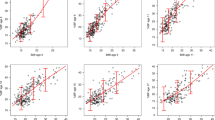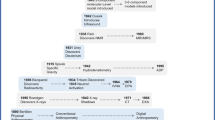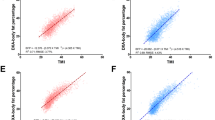Abstract
There are several different methods available for the determination of body fat composition. Two current methods requiring special instrumentation are magnetic resonance imaging (MRI) and dual energy x-ray absorptiometry (DXA). The use of these techniques is very limited despite desirable properties, due to their high costs. Dissection of all fat depots (DF) requires no special instrumentation and allows examination and evaluation of each fat depot in more detail. MRI, DXA, and DF each have their unique advantages and disadvantages when they are applied to animal models. Most studies have determined body fat in young animals, and few studies have been performed in aging models. The aim of this study was to compare MRI, DXA, and DF data in offspring (F1) of mothers fed with control and high-fat diet. We studied rats that varied by age, sex, and maternal diet. The relationships between the three methods were determined via linear regression methods (using log-transformed values to accommodate relativity in the relationships), incorporating when useful age, sex, or diet of the animal. We conclude that the three methods are comparable for measuring body fat, but that direct equivalence gets masked by age, sex, and sometimes dietary group. Depending on the equipment available, the budget of the laboratory, and the nature of the research questions, different approaches may often suggest themselves as the best one.
This is a preview of subscription content, access via your institution
Access options
Subscribe to this journal
Receive 12 print issues and online access
$259.00 per year
only $21.58 per issue
Buy this article
- Purchase on Springer Link
- Instant access to full article PDF
Prices may be subject to local taxes which are calculated during checkout


Similar content being viewed by others
References
Lau EY, Liu J, Archer E, McDonald SM, Liu J. Maternal weight gain in pregnancy and risk of obesity among offspring: a systematic review. J Obes. 2014;2014:524939. https://doi.org/10.1155/2014/524939.
Reilly JJ, Methven E, McDowell ZC, Hacking B, Alexander D, Stewart L, et al. Health consequences of obesity. Arch Dis Child. 2003;88:748–52.
Vega CC, Reyes-Castro LA, Bautista CJ, Larrea F, Nathanielsz PW, Zambrano E. Exercise in obese female rats has beneficial effects on maternal and male and female offspring metabolism. Int J Obes. 2015;39:712.
Sen S, Simmons RA. Maternal antioxidant supplementation prevents adiposity in the Offspring of Western Diet–Fed Rats. Diabetes. 2010;59:3058–65.
Alfaradhi MZ, Kusinski LC, Fernandez-Twinn DS, Pantaleão LC, Carr SK, Ferland-McCollough D, et al. Maternal obesity in pregnancy developmentally programs adipose tissue inflammation in young, lean male mice offspring. Endocrinology. 2016;157:4246–56.
Platt K, Charnigo R, Pearson K. Adult offspring of high-fat diet-fed dams can have normal glucose tolerance and body composition. J Dev Orig Health Dis. 2014;5:229–39.
Björntorp P. Metabolic implications of body fat distribution. Diabetes Care. 1991;14:1132–43.
Duren DL, Sherwood RJ, Czerwinski SA, Lee M, Choh AC, Siervogel RM, et al. Body composition methods: comparisons and interpretation. J Diabetes Sci Technol. 2008;2:1139–46.
Johnson M, Smith D Jr, Nagy T. Validation of quantitative magnetic resonance (QMR) for determination of body composition in rats. Int J Body Compos Res. 2009;7:99.
Vega CC, Reyes‐Castro LA, Rodríguez‐González GL, Bautista CJ, Vázquez‐Martínez M, Larrea F, et al. Resveratrol partially prevents oxidative stress and metabolic dysfunction in pregnant rats fed a low protein diet and their offspring. J Physiol. 2016;594:1483–99.
Lecoutre S, Deracinois B, Laborie C, Eberle D, Guinez C, Panchenko PE, et al. Depot-and sex-specific effects of maternal obesity in offspring’s adipose tissue. J Endocrinol. 2016;230:39–53.
Lukaski HC, Hall CB, Marchello MJ, Siders WA. Validation of dual x-ray absorptiometry for body-composition assessment of rats exposed to dietary stressors. Nutrition. 2001;17:607–13.
Blake GM, Fogelman I. An update on dual-energy x-ray absorptiometry. Semin Nucl Med. 2010;40:62–73.
Tinsley FC, Taicher GZ, Heiman ML. Evaluation of a quantitative magnetic resonance method for mouse whole body composition analysis. Obes Res. 2004;12:150–60.
Nixon JP, Zhang M, Wang C, Kuskowski MA, Novak CM, Levine JA, et al. Evaluation of a quantitative magnetic resonance imaging system for whole body composition analysis in rodents. Obesity. 2010;18:1652–9.
Makan S, Bayley HS, Webber CE. Precision and accuracy of total body bone mass and body composition measurements in the rat using X-ray-based dual photon absorptiometry. Can J Physiol Pharmacol. 1997;75:1257–61.
Bertin E, Ruiz J-C, Mourot J, Peiniau P, Portha B. Evaluation of dual-energy X-ray absorptiometry for body-composition assessment in rats. J Nutr. 1998;128:1550–4.
Lipman R, Smith D, Blumberg J, Bronson R. Effects of caloric restriction or augmentation in adult rats: longevity and lesion biomarkers of aging. Aging Clin Exp Res. 1998;10:463–70.
Rodríguez‐González GL, Reyes-Castro LA, Bautista CJ, et al. Maternal obesity accelerates rat offspring metabolic ageing in a sex-dependent manner. J Physiol. 2019;597:5549–63. https://doi.org/10.1113/JP278232.
Zambrano E, Bautista C, Deas M, Martinez‐Samayoa P, Gonzalez‐Zamorano M, Ledesma H, et al. A low maternal protein diet during pregnancy and lactation has sex‐and window of exposure‐specific effects on offspring growth and food intake, glucose metabolism and serum leptin in the rat. J Physiol. 2006;571:221–30.
Kwekel JC, Desai VG, Moland CL, Branham WS, Fuscoe JC. Age and sex dependent changes in liver gene expression during the life cycle of the rat. BMC Genom. 2010;11:675.
Miller CN, Kauffman TG, Cooney PT, Ramseur KR, Brown LM. Comparison of DEXA and QMR for assessing fat and lean body mass in adult rats. Physiol Behav. 2011;103:117–21.
Nagy TR, Clair AL. Precision and accuracy of dual‐energy X‐ray absorptiometry for determining in vivo body composition of mice. Obes Res. 2000;8:392–8.
Jones A, Johnson M, Nagy T. Validation of quantitative magnetic resonance for the determination of body composition of mice. Int J Body Compos Res. 2009;7:67.
Kuo AH, Li C, Mattern V. et al. Sex-dimorphic acceleration of pericardial, subcutaneous, and plasma lipid increase in offspring of poorly nourished baboons. Int J Obes (Lond). 2018;42:1092–6. https://doi.org/10.1038/s41366-018-0008-2.
Acknowledgements
The authors acknowledge the different grants: CONACyT-SEP (Consejo Nacional de Ciencia y Tecnología-Secretaría de Educación Pública) México (287912) and Newton Fund RCUK-CONACyT (Research Councils UK—CONACyT—I000/726/2016 FONCICYT/49/2016) and ANR-CONACyT 2015-16-273510.
Author information
Authors and Affiliations
Corresponding author
Ethics declarations
Conflict of interest
The authors declare that they have no conflict of interest.
Additional information
Publisher’s note Springer Nature remains neutral with regard to jurisdictional claims in published maps and institutional affiliations.
Rights and permissions
About this article
Cite this article
Castro-Rodríguez, D.C., Ibáñez, C.A., Uribe, J. et al. Strengths and validity of three methods for assessing rat body fat across the life course. Int J Obes 44, 2430–2435 (2020). https://doi.org/10.1038/s41366-020-0619-2
Received:
Revised:
Accepted:
Published:
Issue Date:
DOI: https://doi.org/10.1038/s41366-020-0619-2



